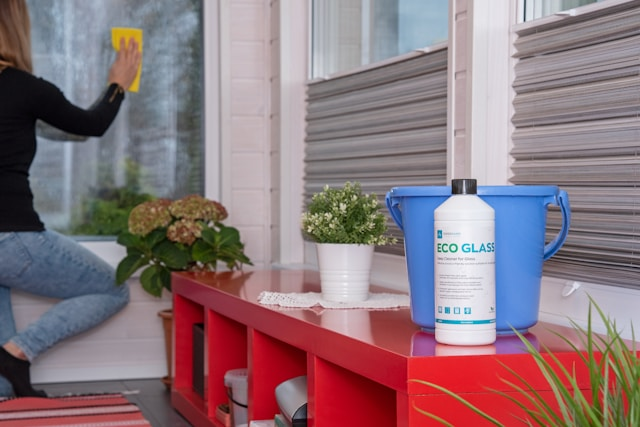Smudges, fingerprints, and water spots seem to find their way onto every glass surface, no matter how frequently you clean. Glass is beautiful because of its clarity. Yet, it is also what makes any flaw immediately obvious. Maintaining that flawless transparency does not have to be an ongoing battle. Glass surfaces not only shine—they stay that way longer—when you use the correct procedures with purpose and precision. When every habit you develop helps to maintain and safeguard that glossy appearance, a shining finish becomes simpler.
1. Use Distilled Water for a Cleaner, Film-Free Finish
Even with premium cleaning products, tap water can include minerals that cause streaks and haze. Distilled water removes those contaminants, thereby enabling your cleaning products to perform at their full potential. Using distilled water to dilute cleaners or rinse surfaces lowers the possibility of producing an invisible film that dulls your glass. Particularly under natural light, this little change makes a clear difference in how clean and crisp the glass looks.
2. Choose the Right Cloth to Avoid Micro-Scratches and Residue
The choice of cloth directly affects the outcome of glass cleaning. Poor-quality fabrics might leave lint or cause fine scratches that, over time, gather filth. Without pushing the fibers around, a premium microfiber towel catches dust, grease, and moisture in its threads. It also lifts, not distributes, fingerprints or film. Keeping a few of these clothes on hand guarantees that every cleaning session leaves your surfaces looking newly polished every time, free of streaks.
3. Apply an Anti-Static Spray to Reduce Dust and Particles
Dust accumulation is one of the fastest ways for glass to lose its sparkle. Particularly in dry interior conditions, airborne particles stick to static-charged surfaces. Between wipes, anti-static sprays build an invisible layer that repels lint and dust, therefore keeping surfaces cleaner. After a deep clean, this helps to avoid quick resettling and lessens the daily care required. The result is a lifetime of clarity that goes beyond the time you stop cleaning.
4. Let Natural Light Guide Your Cleaning Technique
Lighting is essential for detecting smudges and streaks that would otherwise be difficult to see by orienting yourself to clean when light beams directly on the glass; flaws can be seen before they sink in. Natural light makes even coverage across the surface simpler and accentuates irregularities. Changing your angle guarantees that every area—especially around corners and edges where dirt often gathers undetectably—gets the necessary attention.
5. Tackle Buildup with Targeted Products for Deeper Clarity
Even clean glass might seem dull over time from the residue of hard water, cleaning products, and airborne contaminants. A more specific technique becomes required when surfaces stop reacting to normal procedures. Designed to break down mineral deposits, calcium, and other difficult stains that conventional cleaners ignore is a glass stain remover. One periodically brings clarity, smoothness, and resetting of your glass for easier maintenance. It becomes the distinction between simply clean and completely renewed.
6. Keep a Drying Tool in Reach to Prevent Water Spots
Water droplets left over from humidity or cleaning can develop into tough stains that degrade the surface. After every cleaning or shower, using a squeegee removes moisture right away, therefore preventing spots. Perfect for daily usage, a single pass clears the glass free of pressure or abrasion. This simple practice helps you to produce a streak-free atmosphere that calls for less cleaning and extends the lifetime of surfaces.
7. Seal the Surface to Create a Barrier Against Residue
One of the best ways to fight the ongoing accumulation of filth and streaks is with glass protectants. These treatments provide a clear shield that drives away soap scum, water, and oil. Once sealed, the glass gets more smooth to the touch and finds it more difficult for pollutants to stick. This protective layer extends the brightness of your glass and streamlines future cleaning. Maintaining a beautiful finish requires you to lock in cleanliness by eliminating the continuous cycle of wiping and re-wiping.
8. Regular Maintenance Prevents Long-Term Discoloration
The basis of long-lasting gloss is regular maintenance. Ignoring cleanings or using the incorrect products causes small damage that accumulates over time. By establishing a regular schedule depending on the location and use of every glass surface, fingerprints, residue, and environmental deposits are never given the chance to settle permanently. Just a few minutes per week can help you to prevent minor problems before they become obvious, therefore retaining the brightness and sharpness that give glass such appeal in any environment.
Conclusion
Smart techniques, not endless scrubbing, produce longer-lasting clean glass. You simplify your process and increase results by choosing the correct tools, working with illumination, and applying materials that actively preserve surfaces. When every step leads toward long-lasting clarity instead of transient gloss, clear surfaces become easier to maintain. Sparkling glass is not about perfection; it is about consistency, care, and employing strategies that work for you, not against you. Once that rhythm is established, the radiance of each surface speaks for itself.
Are You a Professional?
Requests for your services are coming in left and right. Let’s connect and grow your business, together.


